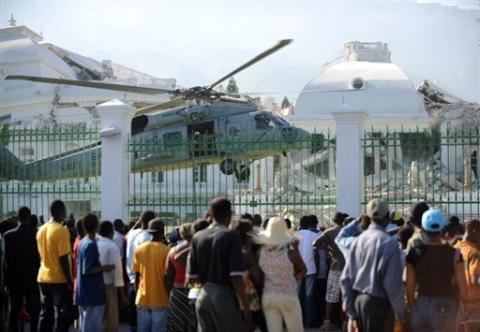We have covered the issue of the progressive campaign for Helmand, the poor resourcing of the Now Zad district until recently, and the inadequate resourcing of the border regions. But the Marines have made no secret of their intent with regards to Marja.
Haji Zair, 45, has just been appointed the new district governor of Marjah, a Taliban stronghold in the center of Afghanistan’s Helmand province. His first goal is just to be able to live there.
The area is still controlled by the Taliban, the last major bastion of the fighters in the southern part of Afghanistan’s most violent province, and for now, Zair only enters the district by day, retreating to his home outside by nightfall.
“The Taliban cannot resist the Marines. They have crushed the Taliban all over the province,” said Zair. “I hope the situation will get better and I can go and live there.”
Some 10,000 U.S. Marines are already Helmand. Most arrived in the first half of last year as part of an earlier escalation ordered by Obama. Obama’s latest push to turn the tide against a worsening insurgency will nearly double the Marines contingent over the next few months.
Last July, in the biggest operation of the eight-year-old war, around 4,000 Marines pushed south of the provincial capital, Lashkar Gah, into Taliban-controlled areas, setting up patrol bases along the way to try and secure the area.
They left one area largely untouched: Marjah, a town surrounded by a dense warren of irrigation canals.
With the new reinforcements on their way as part of Obama’s 30,000-strong troop drive announced last month, the Marines’ commander does not bother to keep his plans a secret.
“Well it’s pretty obvious, there’s only one place left: that’s Marjah. I don’t think its any great leap of logic to say where we’re going next,” said Brigadier General Larry Nicholson, commander of all the Marines in southern Afghanistan.
“We’re bringing in 10,000 Marines. It’s not a secret. There’s only one place left in the entire area of operations where the enemy is at,” he said.
Marjah is strategic, lying just west of the provincial capital. The town is surrounded by lush farmland crisscrossed by canals that water the opium poppy crop, making it a hub for the narcotics trade in central Helmand.
Taliban insurgents are thought to have sought refuge in Marjah after a U.S. Marine operation in Garmsir to the south in April 2008 scattered fighters into other areas. Militants drove out the weak police force, killing the police chief and wounding the then district governor and created a relative safe-haven.
British and Afghan forces carried out isolated offensives there, but without enough forces to hold the ground, they could not prevent the Taliban from reclaiming the area once they had left. Now with much larger numbers, the U.S. Marines plan to go into Marjah and stay there.
“We’re preparing for a fight,” said Nicholson. “Really the enemy has three options in Marjah.”
“One is to stay and fight and probably die. The second one is to make peace with his government and reintegrate. And the third one is to try to flee, in which case we’ll probably have some people out there waiting on them as well,” he said.
The focus on Marjah and other towns along Helmand’s “green zone” — the lush area either side of the river — plays into overall commander General Stanley McChrystal’s new war strategy of protecting population centers and driving insurgents from towns.
Militants are still able to wage their campaign outside towns, frequently attacking smaller patrol bases and laying an increasing number of roadside bombs.
Last year was the deadliest for foreign forces in Afghanistan since the war began. More than twice as many Americans died in 2009 as in 2008, and violence has continued into this year despite the winter that normally sees a lull.
A U.S. Marine and a British journalist were killed by a roadside bomb on Saturday in the Helmand valley.
Nicholson said he hoped the influx of new troops would eventually allow him to move beyond the towns.
“I’m pretty confident that when we get the rest of our Marines in here, when we get the rest of the Afghan security forces in here and we get the rest of the British — because the UK is building up as well — we will have enough security forces here to get after those last pockets where the enemy’s at.”
No, it isn’t a secret, just as the campaign in the Now Zad district wasn’t a secret, and when it was finally fully engaged with the right number of Marines, the Taliban had scurried away knowing that death awaited them if they didn’t leave. Partial success, that was. We cleared Now Zad, but the killers were allowed to escape to Marja and other whereabouts.
Nicholson’s statement is troubling. The second option – “make peace with his government and reintegrate” – makes it clear that he is treating this as a classical insurgency / counterinsurgency campaign. I fear that we have not yet understood that it is that, but much more. There is a religious element, and if a man has fought for years in Garmsir, Now Zad and Dahaneh, and is now in Marja waiting to die at the hands of the U.S. Marines, or to flee across the border to his religious zealot allies, the Pak Taliban, then he cannot possibly be reintegrated with his government.
Nicholson knows that, but it appears that he isn’t smart to the possible game of fake peace. The decoy. The great ruse. The Taliban know that we are short timers there, and that the ANA cannot possibly fill in behind the Marines. Making peace with elements of the Taliban sounds like a nice idea, but it comes with all sorts of hazards and unintended consequences.




